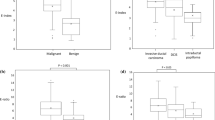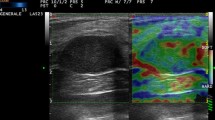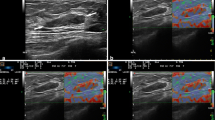Abstract
Background
Elastography is widely used as a diagnostic tool for the diagnosis of invasive breast cancer. However, no study has yet shown if elastography for diagnosing mucinous carcinoma is as useful as that for diagnosing the usual invasive carcinoma. Mucinous carcinoma is considered as a soft tumor. In this study, we used elastography to evaluate the elasticity of mucinous carcinoma.
Methods
Among 1,015 patients who underwent surgery for primary breast cancer between February 2007 and August 2008 in our facility, the final pathological diagnosis showed only 32 mucinous carcinomas. We evaluated 16 of the 32 mucinous carcinoma patients who underwent preoperative elastography.
Results
There were 13 cases of the pure-type and 3 cases of the mixed-type mucinous carcinoma. B-mode ultrasound (US) imaging showed mass formation in 16 patients. The elasticity score was 2 in 1 case (8%), 3 in 3 cases (23%), 4 in 7 cases (54%), and 5 in 2 cases (15%). The fat-to-lesion ratio (FLR) was evaluated in 7 cases. The mean value of the FLR was 12 (range 3–30).
Conclusion
Twelve of the 16 (75%) cases had an elastography score of 4 or 5. Although mucinous carcinoma had an elastography score similar to that of usual invasive carcinoma, elastography may be useful for distinguishing mucinous carcinoma from benign fibroadenoma.




Similar content being viewed by others
References
Itoh A, Ueno E, Tohno E, Kamma H, Takahashi H, Shiina T, et al. Breast disease: clinical application of US elastography for diagnosis. Radiology. 2006;239(2):341–50.
Ueno E, Umemoto T, Bando H, Tohno E, Waki K, Matsumura T. New quantitative method in breast elastography: fat-lesion ratio (FLR) (abstract). In: Proceedings of the Radiological Society of North America Scientific Assembly and Meeting. Oak Brook, IL: Radiological Society of North America. 2007; 697.
Nyugankenshinnihituyonabyorigakutekitishiki, Sakamoto G. J Jpn Assoc Breast Cancer Screen. 2001;10(2):153–58.
Regini E, Bagnera S, Tota D, Campanino P, Luparia A, Barisone F, et al. Role of sonoelastography in characterising breast nodules. Preliminary experience with 120 lesions. Radiology medicine. 2010;115(4):551–62.
Schaefer FKW, Heer I, Schaefer PJ, Mundhenke C, Osterholz S, Order BM et al. Breast ulotrasound elastography—results of 193 breast lesions in a prospective study with histopathologic correlation. Eur J Radiol. 2011;77(3):450–6.
Tohno E, Ueno E. Current improvements in breast ultrasound, with a special focus on elastography. Breast Cancer. 2008;15:200–4.
Zhu QL, Jiang YX, Liu JB, Liu H, Sun Q, Dai Q, et al. Real-time ultrasound elastography: its potential role in assessment of breast lesions. Ultrasound Med Biol. 2008;34:1232–8.
Scaperrotta G, Ferranti C, Costa C, Mariani L, Marchesini M, Suman L, et al. Role of sonoelastography in non-palpable breast lesions. Eur Radiol. 2008;18:2381–9.
Fleury EF, Rinaldi JF, Piato S, Fleury JC, Roveda Junior D. Appearence of breast masses on sonoelastography with special focus on the diagnosis of fibroadenomas. Eur Radiol. 2009;19:1337–46.
Author information
Authors and Affiliations
Corresponding author
About this article
Cite this article
Mori, M., Tsunoda, H., Kawauchi, N. et al. Elastographic evaluation of mucinous carcinoma of the breast. Breast Cancer 19, 60–63 (2012). https://doi.org/10.1007/s12282-011-0268-3
Received:
Accepted:
Published:
Issue Date:
DOI: https://doi.org/10.1007/s12282-011-0268-3




